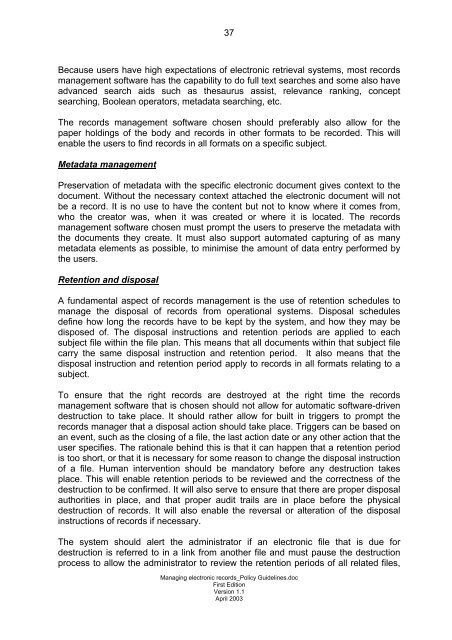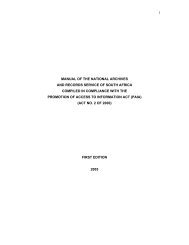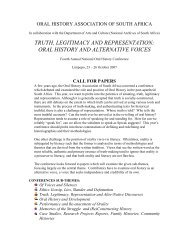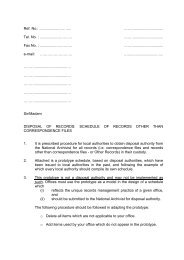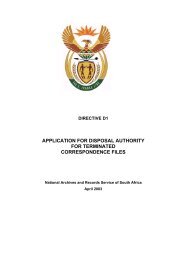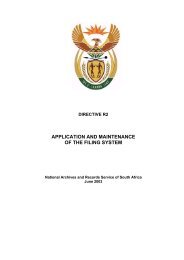managing electronic records in governmental bodies - National ...
managing electronic records in governmental bodies - National ...
managing electronic records in governmental bodies - National ...
You also want an ePaper? Increase the reach of your titles
YUMPU automatically turns print PDFs into web optimized ePapers that Google loves.
37<br />
Because users have high expectations of <strong>electronic</strong> retrieval systems, most <strong>records</strong><br />
management software has the capability to do full text searches and some also have<br />
advanced search aids such as thesaurus assist, relevance rank<strong>in</strong>g, concept<br />
search<strong>in</strong>g, Boolean operators, metadata search<strong>in</strong>g, etc.<br />
The <strong>records</strong> management software chosen should preferably also allow for the<br />
paper hold<strong>in</strong>gs of the body and <strong>records</strong> <strong>in</strong> other formats to be recorded. This will<br />
enable the users to f<strong>in</strong>d <strong>records</strong> <strong>in</strong> all formats on a specific subject.<br />
Metadata management<br />
Preservation of metadata with the specific <strong>electronic</strong> document gives context to the<br />
document. Without the necessary context attached the <strong>electronic</strong> document will not<br />
be a record. It is no use to have the content but not to know where it comes from,<br />
who the creator was, when it was created or where it is located. The <strong>records</strong><br />
management software chosen must prompt the users to preserve the metadata with<br />
the documents they create. It must also support automated captur<strong>in</strong>g of as many<br />
metadata elements as possible, to m<strong>in</strong>imise the amount of data entry performed by<br />
the users.<br />
Retention and disposal<br />
A fundamental aspect of <strong>records</strong> management is the use of retention schedules to<br />
manage the disposal of <strong>records</strong> from operational systems. Disposal schedules<br />
def<strong>in</strong>e how long the <strong>records</strong> have to be kept by the system, and how they may be<br />
disposed of. The disposal <strong>in</strong>structions and retention periods are applied to each<br />
subject file with<strong>in</strong> the file plan. This means that all documents with<strong>in</strong> that subject file<br />
carry the same disposal <strong>in</strong>struction and retention period. It also means that the<br />
disposal <strong>in</strong>struction and retention period apply to <strong>records</strong> <strong>in</strong> all formats relat<strong>in</strong>g to a<br />
subject.<br />
To ensure that the right <strong>records</strong> are destroyed at the right time the <strong>records</strong><br />
management software that is chosen should not allow for automatic software-driven<br />
destruction to take place. It should rather allow for built <strong>in</strong> triggers to prompt the<br />
<strong>records</strong> manager that a disposal action should take place. Triggers can be based on<br />
an event, such as the clos<strong>in</strong>g of a file, the last action date or any other action that the<br />
user specifies. The rationale beh<strong>in</strong>d this is that it can happen that a retention period<br />
is too short, or that it is necessary for some reason to change the disposal <strong>in</strong>struction<br />
of a file. Human <strong>in</strong>tervention should be mandatory before any destruction takes<br />
place. This will enable retention periods to be reviewed and the correctness of the<br />
destruction to be confirmed. It will also serve to ensure that there are proper disposal<br />
authorities <strong>in</strong> place, and that proper audit trails are <strong>in</strong> place before the physical<br />
destruction of <strong>records</strong>. It will also enable the reversal or alteration of the disposal<br />
<strong>in</strong>structions of <strong>records</strong> if necessary.<br />
The system should alert the adm<strong>in</strong>istrator if an <strong>electronic</strong> file that is due for<br />
destruction is referred to <strong>in</strong> a l<strong>in</strong>k from another file and must pause the destruction<br />
process to allow the adm<strong>in</strong>istrator to review the retention periods of all related files,<br />
Manag<strong>in</strong>g <strong>electronic</strong> <strong>records</strong>_Policy Guidel<strong>in</strong>es.doc<br />
First Edition<br />
Version 1.1<br />
April 2003


